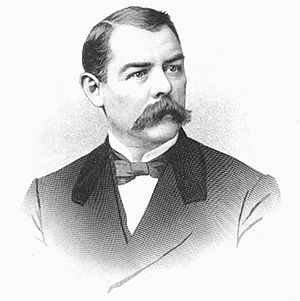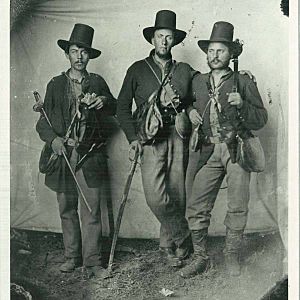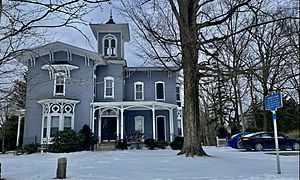Albion W. Tourgée facts for kids
Albion Winegar Tourgée (May 2, 1838 – May 21, 1905) was an American soldier, lawyer, writer, politician, and diplomat. He was a brave soldier in the Civil War. After the war, he moved to North Carolina. There, he worked hard during the Reconstruction period to help rebuild the South.
Tourgée was a pioneer for civil rights. He helped start the National Citizens' Rights Association. He also founded Bennett College, which was a school for formerly enslaved people. Later, it became a college for women. He strongly believed in fairness for all people.
He is famous for his work on the landmark Plessy v. Ferguson case in 1896. He was the main lawyer for the side that wanted to end segregation. Segregation meant keeping Black and white people separate in public places. The Supreme Court decided that "separate but equal" was allowed. This ruling unfortunately led to many years of segregation. Tourgée is known for using the idea of "color-blind justice" in law. This means treating everyone the same, no matter their race.
Contents
Early Life and Education
Albion Tourgée was born on May 2, 1838, in a small town called Williamsfield, Ohio. His mother passed away when he was only five years old. He went to local schools in Ashtabula County. He also lived with his uncle for two years in Lee, Massachusetts.
In 1859, Tourgée started college at the University of Rochester. He became interested in politics when the university tried to ban a student group. He stood up to the school leaders and found a way for the group to stay. He had to leave college in 1861 because he ran out of money. He worked as a teacher to save up so he could go back.
The Civil War started in April 1861. Tourgée joined the 27th New York Volunteer Infantry. Even though he left college early to fight, the university still gave him his degree in 1862. This was a common practice for students who joined the military.
Military Service in the Civil War
Tourgée fought in the First Battle of Bull Run. This was one of the first big battles of the war. He was hurt in his back during this battle. This injury caused him problems for the rest of his life.
After he recovered, he became a first lieutenant. He joined the 105th Ohio Volunteer Infantry. He was wounded again at the Battle of Perryville.
In January 1863, Tourgée was captured by enemy soldiers. He was held as a prisoner-of-war in Libby Prison in Richmond, Virginia. He was released a few months later in May 1863. He went back to fight with the Union army. He fought in the battles of Chickamauga and Chattanooga. Because of his health problems from his injuries, he left the army in December 1863.
He returned to Ohio and married his childhood sweetheart, Emma Doiska Kilbourne. They had one child together.
Working for Change During Reconstruction
After the war, Tourgée studied law and became a lawyer. He and his wife moved to Greensboro, North Carolina. The warmer weather there was better for his war injuries. He became a lawyer, a farmer, and an editor for a newspaper.
Some people in the South called him a "carpetbagger." This was a term for Northerners who moved South after the war. Tourgée played many important roles during the Reconstruction period. He used his experiences from this time to write novels later on.
In 1868, he was chosen to represent Guilford County at the state's constitutional convention. This meeting was mostly led by Republicans. He strongly supported equal political and civil rights for all people. He also pushed for free public education and fair laws. He worked to make sure judges were elected by the people. He also helped get rid of harsh punishments like whipping.
Tourgée was elected as a judge for the 7th District superior court. He served from 1868 to 1874. During this time, he faced the Ku Klux Klan, a violent group. They were very powerful in his area and often threatened him. He also helped combine North Carolina's old law systems into one new, simpler system. This new system made laws more flexible.
A Life of Writing
Albion Tourgée started writing novels while living in North Carolina. His first novel, Toinette, was published in 1874. He used the pen name "Henry Churton" for this book.
He became very successful after his novel A Fool's Errand, by One of the Fools came out in 1879. This book was based on his experiences during Reconstruction. It sold 200,000 copies! His next book, Bricks Without Straw (1880), was also a bestseller. These books were special because they showed events from the point of view of formerly enslaved people. They showed how the promise of freedom was often limited by violence and unfair treatment after the war.
In 1881, Tourgée and his family moved back North to Mayville, New York. He worked as a writer and editor for a magazine, but it closed in 1884. He wrote many more novels and essays over the next twenty years. Many of his stories were set in the Lake Erie region where he lived. One of his books, Murvale Eastman: Christian Socialist (1890), explored ideas of social justice from a Christian viewpoint.
The Plessy v. Ferguson Case
Towards the end of the 1800s, many Southern states started passing new laws. These laws made it harder for Black people to vote. They also created legal segregation in public places. For example, Louisiana passed a law in 1890. This law said that all train companies had to have "equal but separate accommodations" for white and Black passengers. This meant separate train cars or sections.
In 1891, a group of Black leaders in New Orleans formed a "Citizens' Committee." They wanted to challenge this unfair law. They asked "Judge Tourgée," as he was known, to help them.
Tourgée was known for speaking out against unfair treatment of Black people. He wrote a popular newspaper column where he criticized segregation and other injustices. Because of his strong views, the New Orleans Citizens' Committee chose him to lead their legal fight against the new Louisiana law.
Tourgée played a smart role in planning the challenge. He suggested that a light-skinned, mixed-race African American should challenge the law. This was to show how confusing and unfair the segregation rules were. First, Dan Desdunes was chosen, but his case was dismissed. Then, Homer Plessy was chosen. Plessy was arrested after he got on a train and refused to move from a "white" car to a "colored" car.
Tourgée was the main lawyer for Homer Plessy. In his legal papers for the Plessy case, he used the term "color blindness." He had used this idea before in his work for civil rights. He believed the law should not see a person's race. Justice John Marshall Harlan, one of the Supreme Court judges, later used Tourgée's idea of "color blindness" in his famous disagreement with the court's decision.
Later Life and Legacy
After the Plessy case, Tourgée was asked to help Ida B. Wells. She was an anti-lynching activist who was sued for writing about an event in Memphis. Tourgée had mostly stopped practicing law, but he recommended his friend, Ferdinand Lee Barnett, to help her. Barnett agreed to take the case. He later married Ida B. Wells.
In 1897, President William McKinley appointed Tourgée as a U.S. consul to France. He moved to Bordeaux for this job. Around 1900, Tourgée joined a group for Civil War veterans who had been officers.
Tourgée served in France until he passed away in 1905. He had been sick for several months. His death was caused by kidney problems, which were thought to be related to his Civil War injury.
Albion Tourgée's ashes are buried in the Mayville Cemetery in Mayville, New York. A tall stone monument marks his grave. It has a quote that says: I pray thee then Write me as one that loves his fellow-man. This shows his lifelong dedication to helping others.
Books by Albion W. Tourgée
Fiction
- Toinette (1874)
- Figs and Thistles: A Western Story (1879)
- A Fool's Errand (1879)
- Bricks Without Straw (1880)
- 'Zouri's Christmas (1881)
- John Eax and Marmelon; or, The South Without the Shadow (1882)
- Hot Plowshares (1883)
- The Veteran and His Pipe (1886)
- Button's Inn (1887)
- Black Ice (1888)
- With Gauge and Swallow, Attorneys (1889)
- Murvale Eastman, Christian Socialist (1890)
- Pactolus Prime (1890)
- '89 (1891)
- A Son of Old Harry (1892)
- Out of the Sunset Sea (1893)
- An Outing with the Queen of Hearts (1894)
- The Mortgage on the Hip-Roof House (1896)
- The Man Who Outlived Himself (1898) stories
Nonfiction
- The Code of Civil Procedure of North Carolina, with Barringer & Rodman (1878)
- An Appeal to Caesar (1884)
- Letters to a King (1888)
- The War of the Standards: Coin and Credit vs. Coin Without Credit (1896)
- The Story of a Thousand, Being a History of the 105th Volunteer Infantry, 1862-65 (1896)
- A Civil War Diary, ed by Dean H. Keller (post, 1965)





